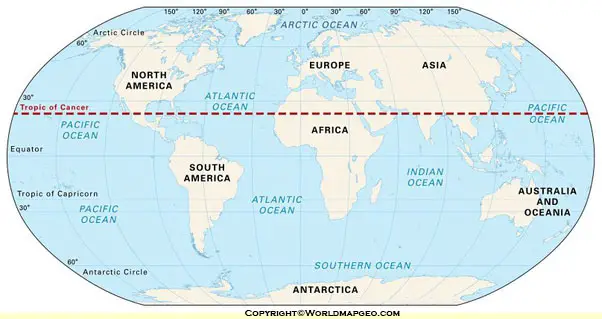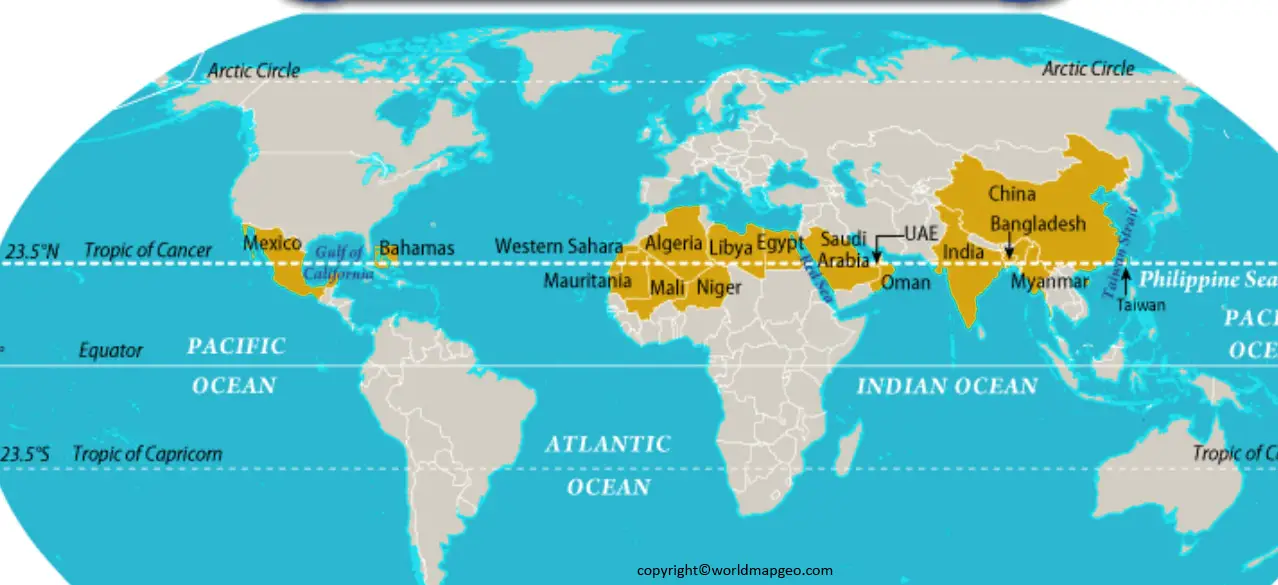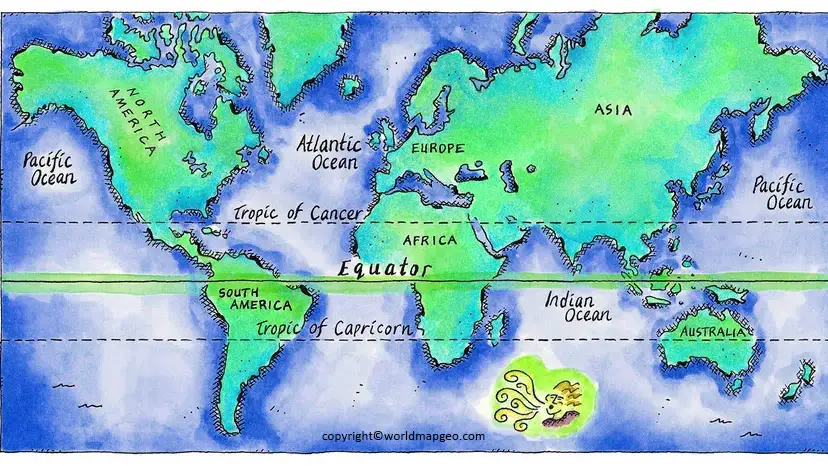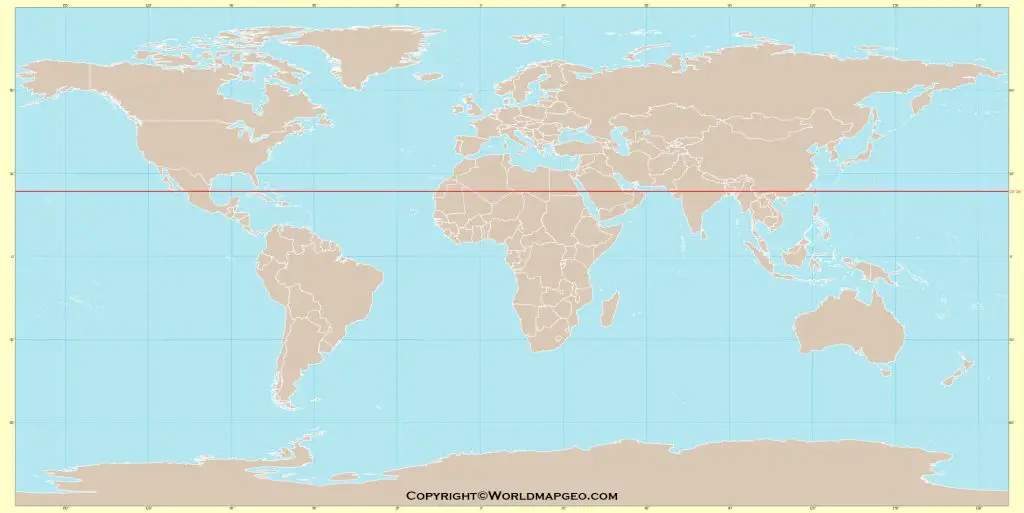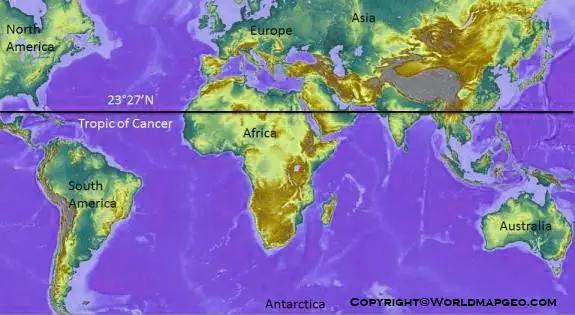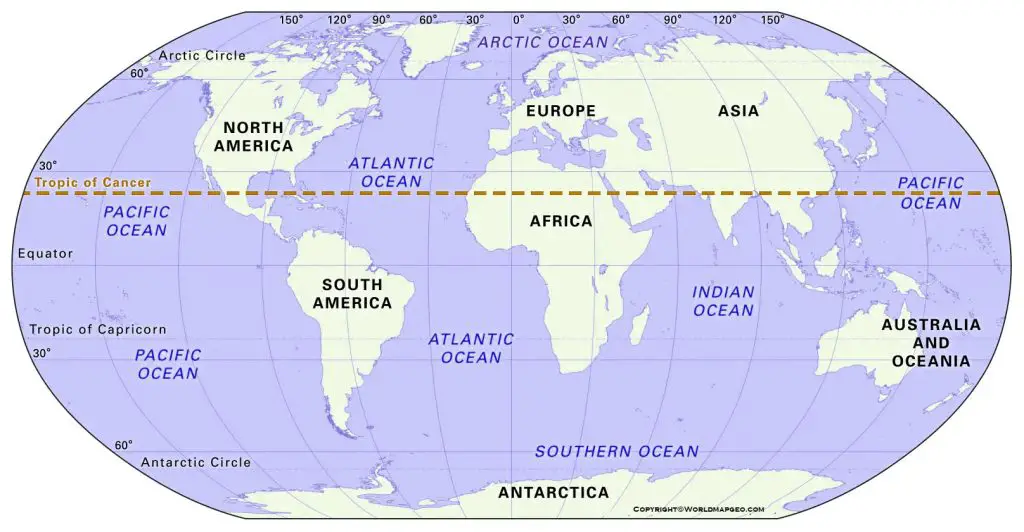Tropic of Cancer Map, 23°27′ north of the terrestrial Equator. This latitude corresponds to the Sun’s ecliptic’s northernmost declination from the celestial Equator. Around June 21, the Northern Hemisphere’s summer solstice, the Sun reaches its most incredible declination north and passes directly over the Tropic of Cancer. The Sun is in the constellation Gemini at the time, but it was in the constellation Cancer far earlier in history, earning it the name Tropic of Cancer. The Sun will reappear in the constellation Cancer in roughly 24,000 years due to a slow change in the direction of Earth’s axis of rotation.
Tropic of Cancer Map
The Tropic of Cancer is an important geographical line that circles the Earth at approximately 23.5 degrees north of the equator. It marks the northernmost point where the Sun appears directly overhead during the summer solstice in the Northern Hemisphere. This significant line is represented on the Tropic of Cancer map, which displays the specific location and path of this latitude across the globe.
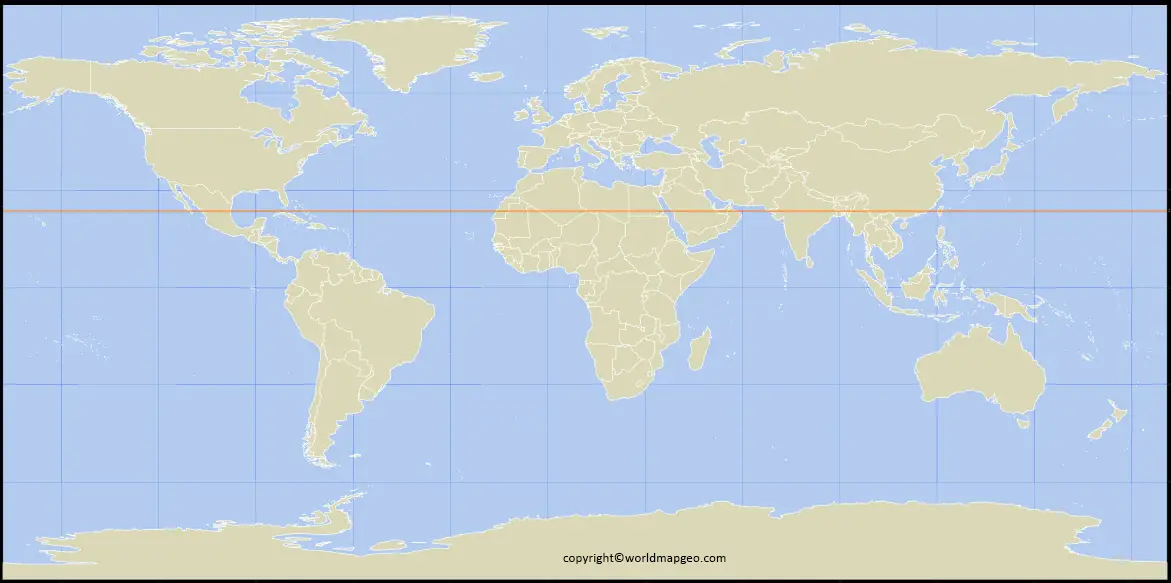
The Tropic of Cancer passes through numerous countries, regions, and landscapes, making it a vital reference point for understanding global climates and ecosystems. On the map, it is clearly indicated as a parallel line that runs from the eastern to the western hemisphere. Countries that lie along the Tropic of Cancer include Mexico, the Bahamas, Egypt, Saudi Arabia, India, and China, among others.
Exploring the Tropic of Cancer map allows travelers, scientists, and geographers to gain insights into the unique characteristics of the regions it crosses. The areas near the Tropic of Cancer experience distinctive weather patterns, with hot and arid conditions being prevalent in many places. Additionally, these regions often showcase diverse flora and fauna, as they serve as transitional zones between the tropical and temperate climates.
In conclusion, the Tropic of Cancer map is a valuable tool for understanding the Earth’s geographical features and the impact of its position on climate and ecosystems. It not only provides vital information for research and exploration but also offers a deeper appreciation for the planet’s natural diversity. Check out other World Maps:- Mountain Ranges Map, 3D World Map, World Map HD.
Tropic of Cancer on Map
The Tropic of Cancer, an essential geographical line, is prominently depicted on maps of the world. This significant circle of latitude lies at approximately 23.5 degrees north of the equator, running parallel to the equatorial line. When observing the Tropic of Cancer on the map, it can be seen cutting across various countries and continents, offering valuable insights into the Earth’s geography.
Understanding the Tropic of Cancer’s position on the map is crucial for comprehending its climatic and astronomical implications. During the summer solstice in the Northern Hemisphere, the Sun is directly overhead along the Tropic of Cancer, resulting in the longest day of the year. This phenomenon has significant cultural and historical importance in many regions, influencing traditions, festivals, and agricultural practices.
One notable region where the Tropic of Cancer passes through is India. The city of Jaipur, located near the Tropic of Cancer, witnesses an interesting astronomical event known as the “Zero Shadow Day.” On this day, objects cast no shadow at noon due to the Sun’s position directly above the Tropic of Cancer.
The Tropic of Cancer’s presence on the map also facilitates a deeper understanding of global weather patterns. Areas near this latitude often experience hot and dry climates, which have a profound impact on the local ecosystems, agriculture, and human habitation.
In conclusion, the depiction of the Tropic of Cancer on maps provides valuable information about the Earth’s axial tilt, climate patterns, and cultural significance. It serves as a reminder of the intricate relationship between our planet’s geography, astronomy, and human societies.
Earth Map Tropic of Cancer
When examining the Earth map, the Tropic of Cancer stands out as a significant circle of latitude running parallel to the equator at approximately 23.5 degrees north. This imaginary line plays a crucial role in determining the planet’s climate and seasonal changes, making it an essential reference point for geographers and scientists.
The Tropic of Cancer is part of a pair of lines known as the Tropics of Cancer and Capricorn, which are the northernmost and southernmost points where the Sun appears directly overhead, respectively. These lines mark the boundaries of the tropical zone, characterized by warm temperatures and distinct wet and dry seasons.
One of the regions greatly affected by the Tropic of Cancer’s position is Mexico. This country experiences diverse climates due to its vast size and varying elevations. Parts of Mexico, lying along the Tropic of Cancer, tend to have arid or semi-arid climates, while other areas enjoy tropical weather with abundant rainfall.
The Earth map with the Tropic of Cancer also provides valuable insights into the migratory patterns of various species. Birds, in particular, use this latitude as a reference point during their seasonal journeys. As the Tropic of Cancer shifts between the northern and southern hemispheres, these migratory creatures follow the path of warmth and resources.
Moreover, the Tropic of Cancer has played a significant historical and cultural role in various societies. Ancient civilizations, like the Egyptians and Mayans, had knowledge of celestial events related to the Tropic of Cancer, which influenced their agricultural practices and religious ceremonies.
Tropic of Cancer Map on World Map
The Tropic of Cancer Map, when overlaid on the world map, reveals fascinating insights into the Earth’s axial tilt and its influence on global weather patterns. This vital circle of latitude runs approximately 23.5 degrees north of the equator, marking the northernmost point where the Sun appears directly overhead during the summer solstice in the Northern Hemisphere.
As we observe the Tropic of Cancer on the world map, we can identify the countries and regions it passes through. From the Atlantic Ocean, it traverses through North America, touching parts of Mexico, the Bahamas, the Sahara Desert in Africa, the Arabian Peninsula, the Indian subcontinent, and Southeast Asia. It then continues through China before entering the Pacific Ocean.
The Tropic of Cancer’s position on the world map has profound implications for the climate and ecosystems of the regions it crosses. Areas near this latitude experience hot and dry weather conditions, with some regions facing extreme heat and aridity. These climates shape the unique flora and fauna found in these regions and influence human settlements and economic activities.
One of the well-known regions impacted by the Tropic of Cancer is the Thar Desert in India. This arid region experiences scorching temperatures during the summer months when the Sun is directly overhead. The Tropic of Cancer’s presence on the map helps in understanding the causes behind such extreme climatic conditions.
Furthermore, the Tropic of Cancer’s influence extends beyond weather patterns; it also affects cultural practices and festivities. For instance, in India, the summer solstice is celebrated as the festival of Makar Sankranti, signifying the end of the winter solstice and the beginning of longer, sunnier days.
